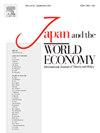The anchoring of inflation expectations in Japan: A learning-approach perspective
IF 1.2
4区 经济学
Q3 ECONOMICS
引用次数: 0
Abstract
This paper uses a learning model to jointly estimate long-term inflation expectations and the degree of anchoring in Japan since the 1960s. We find that in the 1970s, Japan had higher long-term inflation expectations than the U.S. during the first oil shock, but much lower inflation expectations after the second oil shock. This contrast between Japan and the U.S. is consistent with many studies that attribute the differences in the inflation dynamics between Japan and the U.S. to the monetary policy stance in Japan during the 1970s and early 1980s. Long-term inflation expectations fell to around 2 percent in the late 1980s and remained anchored until the mid-1990s. They fell below 2 percent in the late 1990s, resulting in a low degree of anchoring until the early 2010s. Since early 2013, inflation expectations have risen but are not yet been anchored to the target. Further VAR analysis suggests that declining markups could be a primary source for hindering the anchoring of inflation expectations in Japan.
日本通胀预期的锚定:一个学习方法的视角
本文采用学习模型对日本20世纪60年代以来的长期通胀预期和锚定程度进行了联合估计。我们发现,在20世纪70年代,日本在第一次石油危机期间的长期通胀预期高于美国,但在第二次石油危机之后,通胀预期要低得多。日本和美国之间的这种对比与许多研究一致,这些研究将日本和美国之间通货膨胀动态的差异归因于日本在20世纪70年代和80年代初的货币政策立场。长期通胀预期在上世纪80年代末降至2%左右,并一直稳定到90年代中期。在20世纪90年代末,它们跌至2%以下,导致低程度的锚定,直到2010年代初。自2013年初以来,通胀预期有所上升,但尚未稳定在目标水平。进一步的VAR分析表明,加价下降可能是阻碍日本通胀预期稳定的主要原因。
本文章由计算机程序翻译,如有差异,请以英文原文为准。
求助全文
约1分钟内获得全文
求助全文
来源期刊

Japan and the World Economy
ECONOMICS-
CiteScore
2.60
自引率
0.00%
发文量
26
审稿时长
46 days
期刊介绍:
The increase in Japan share of international trade and financial transactions has had a major impact on the world economy in general and on the U.S. economy in particular. The new economic interdependence between Japan and its trading partners created a variety of problems and so raised many issues that require further study. Japan and the World Economy will publish original research in economics, finance, managerial sciences, and marketing that express these concerns.
 求助内容:
求助内容: 应助结果提醒方式:
应助结果提醒方式:


